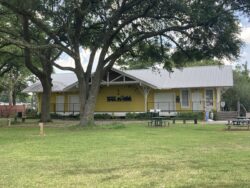The Orphan Train Museum
Opelousas commemorates a complex child welfare project
Published: November 30, 2023
Last Updated: February 29, 2024

Photo by Sabrina Stone
Volunteer-run, with 2,400 square feet filled with folksy charm and mementos, the Orphan Train Museum is clearly a town effort. There are lanterns, donated by people from the railroad company; a hand-carved cuckoo clock with a train that goes around it; hand-sewn tablecloths with train patterns. Every picture on the wall and every artifact in a case was donated by a local family. Babydolls rest in carriages that look just like the ones from the old photographs, and a full wall mural depicts the arrival of the little train riders into town.
The origins of the Orphan Train movement can be traced back to 1853, in New York City, when Charles Loring Brace founded the Children’s Aid Society—and the beginning of a free foster care system. Seeking a housing solution for the destitute children he took in from the streets (or from families who couldn’t afford to keep them, or from unwed mothers who gave birth in religious hospitals and were denied their rights to take them home), Brace devised a plan. He advertised for placements for these children, away from the overcrowded shelters of New York City and into homes in the south and west, where the children could start new lives in the countryside, mainly on farms. Some children were taken in by loving families; some were never officially adopted, treated poorly, and used exhaustively as free labor.
The Orphan Train network existed twelve years before slavery became illegal, and it is worth noting that many of these children were being transported from free states into pro-slavery areas. The movement faced some opposition from those who thought that taking in children for free and putting them to work would cut into the slave trade. Other objections concerned the health and character of the children arriving in these small towns—that they were criminal or carrying disease. Lack of sufficient oversight was another cause for concern. And the Orphan Train network, which was run primarily by clergy, was also criticized for force-baptizing every child, regardless of the child’s original faith.
The Orphan Train Museum is full of stories with striking detail. Sister Marie Anselen Duffle, who was white, was taken in as a child by a Creole family; she ultimately joined a Black order of nuns and became the mother superior. Sister Faubacher was a special-order child; her prospective father owned Jax Brewery, and his nephew had placed an order for a little boy. When she arrived, her uncle said, “Put her back on the train. My wife will kill me!” but Peter J. Faubacher thought she was too beautiful to give up and brought her home instead. Her case has a rosary surrounded by beer bottles, a picture of her father holding her at the train depot, and a tag with her birth name, Sarah Hunt. Newberg’s department store, in Avoyelles Parish, was owned by two Orphan Train riders, Charles Singe and Mildred Fickert, who married each other. Joseph Rouguet Aillet came to Louisiana when he was two years old; there was nobody to greet the train, so a priest’s housekeeper took him in. Among other accomplishments, he coached Terry Bradshaw; today Louisiana Tech’s stadium is named after him.
By 1929 shipping children off on trains was illegal, and the welfare system had made enough infrastructural advancements to retain orphans in the regions where they were born. But this brief movement had a huge impact: approximately four million descendants of Orphan Train riders are alive in the United States today. In 2015 we lost Alice “Kearns” (Geoffrey) Bernard, Louisiana’s last-known Orphan Train rider. When the museum opened in 2009, Alice was crowned “Queen for a Day.” On display are the dress, bonnet, and shoes Alice wore when she arrived on the train in New Iberia, and, by her own request, a picture of her cat, Minou.
Sabrina Stone is a NYC–born, New Orleans–based musician and writer. Her work has been featured in OffBeat, I’m Music Magazine, Very Local, Where Y’at, ANTIGRAVITY, Hello Giggles, Quarterlette, Femsplain, and the Huffington Post. She has released four solo albums, fronts local band WAR BUNNIES, and is the editor-in-chief of the New Orleans Arts Rag.
